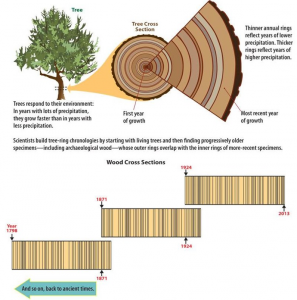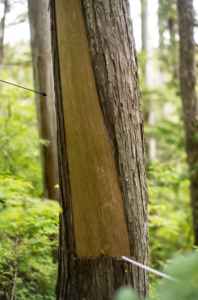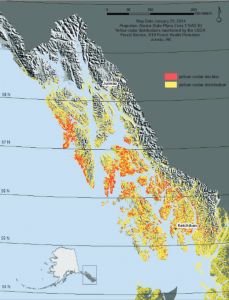Each year, a tree grows a ring and this ring can tell us about the climate, growth, and factors influencing the tree that year. The thickness of a ring can tell us the environmental conditions like whether there had been a flood or drought. To study trees, we can take cores with coring tools. This does not harm or kill the tree. We can then analyze the three -rings in each core using principles of dendrochronology.
One principle of dendrochronology is the principle of cross-dating. Because tree rings give us calendar years, we can match previously recorded ring series with new samples to get the years when the tree was living. It’s as if the rings are barcodes; we can match up the lines (rings) to develop and extend a ring-width timeline (see Figure 1 below).

Another principle of tree-ring analysis is the principle of limiting factors. Limiting factors are environmental factors that can limit the growth of trees. Some examples include temperature, precipitation, sunlight, and nutrients. If a tree experiences a drought, this will be shown in the relative width of the tree rings.
The principle of ecological amplitude suggests that samples should be collected from trees along the edges of environments since those are the most sensitive. These trees will have the best indicators of the past and the climate it went through within its record. For example, one can compare the rings between high elevation and lower elevation trees.
There are many other principles that are applied when studying tree cores, but for the purpose of this blog post and the work done with the TRAYLS group, we wanted to keep the information basic and applied as they cored trees at low and high elevations on Chicagof Island near Hoonah, Alaska.
The TRAYLS group has started coring trees and given us their written data thus far. Julia, one of my classmates and partners in this summer work, created a Google Earth interactive map that has plotted the trees. You can interact with the Google Earth link below.
Alaska Cedar
Today, we are seeing a decline in cedar population in Alaska due to climate change (Hennon, 2016). This is a problem because yellow cedar contributes to Alaska’s economy and has high value in native culture. Yellow cedar is used for strong materials such as paddles, baskets, mats, and many more items. For native culture, cedar is used for totem poles, chests, dishes, and tool handles. Cedar is also important for wood carving. To get the material, the cedar trees are stripped, and the striped bark is soaked. The stripping process is an art and a tradition for native peoples including the Tlingit (Hennon, 2016).


Dr. Ben Gaglioti (University of Alaska – Fairbanks) presented his research to me and other students working under Dr. Wiles in May. The presentation covered cedar basics and information that we could present to the TRAYLS group in our first meeting with them. He also provided the presentation slides to us to use which was a big help in explaining the basics in a visual way. He also discussed the importance of tree ring dating to date glacial advance. Dating when glacier’s advance is just one of the things we can determine using tree cores. Using tree ring dating to determine glacial advance was the focus of my Junior IS that I completed this past spring.
Cedar Decline

The decline of cedar in response to a changing climate is suggested to be caused from warming temperatures. Because the temperature is rising, the snowpack that forms around the roots and the base of the trees are melting. Snowpacks act as insulators and protect the roots from cold snaps in the winter. The melting snowpack leaves the roots exposed and vulnerable. The warming temperature also influences the timing of dehardening which kills the cedar.
